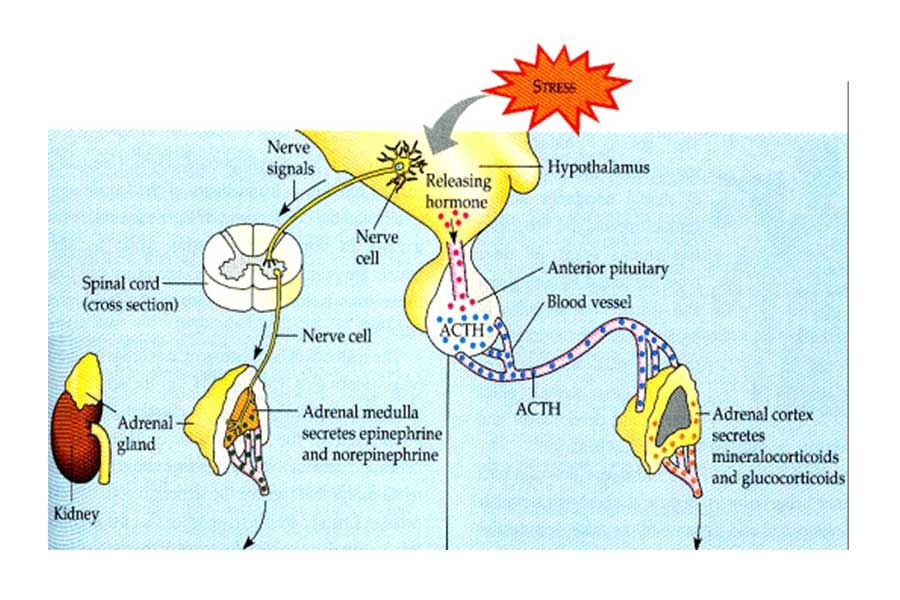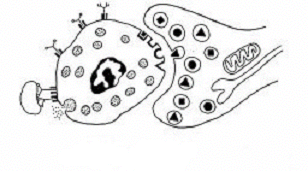The Biochemistry of Energy Psychology
An Immunologist’s Perspective on Physiological Mechanisms Underlying Energy Psychology Treatments
Judith Swack: I just wanted to tell you that for my Ph.D. I had to major in three areas. Since I was already an expert in enzymology, I majored instead for my Ph.D. in molecular biology, immunology, and neurochemistry. So, today, folks, we’re going to get into heavy chemistry. But let me start by saying that because I applied for many NIH grants to fund my research, I understand that procedures are absolutely critical if you want anything from an agency. So we will start by doing the official CEU paperwork.
Slide 1 Objectives for CE credits
On completion of this program, the participant will be able to:
1. Name at least two well-researched physiological mechanisms most likely involved in Energy Psychology treatments
2. Cite at least two research studies from the fields of physiology and immunology that indirectly support the notion that Energy Psychology could be effective
3. Describe at least one theory from the field of immunology that provides indirect theoretical support for the potential usefulness of energy interventions as appropriate psychotherapeutic adjuncts.
Name three objectives. At the end of this seminar, you will all be able to name at least two well-researched physiological mechanisms most likely involved in energy psychology treatments. You will all be able to cite at least two research studies from the fields of physiology and immunology that indirectly– well, I think directly support the notion that energy psychology is effective. You will be able to describe at least one theory from the field of immunology that provides direct theoretical support for the usefulness of energy interventions as appropriate psychotherapeutic adjuncts.
[applause, cries of “you go girl” ]
JS: There will be a quiz at the end of this talk. All right, next slide please.
Slide 2 References
Guyton, A.C. and Hall, J.E. Textbook of Medical Physiology, 10 edition, W.B. Saunders Co. NY, 2000
Ulett, G.A., Beyond Yin and Yang; How Acupuncture Really Works Warren S. Green and Co., Inc. St. Louis, , 1992
Stefano, G.B., Fricchione, G.L., Slingsby, B.T., and Benson, H. “The placebo effect and relaxation response: neural processes and their coupling to constitutive nitric oxide” in Brain Research Reviews 35:1-19, 2001
Swack, J.A. (1992) “A study of initial response and reversion rates of subjects treated with the allergy technique.” Anchor Point 6, 3:1-10
These are the references I used for the scientific part of my seminar. I took the body of my seminar today from the classic medical physiology textbook by Guyton and Hall. This book is fascinating and beautifully written. This is a must read; I couldn’t put it down.
[laughter]
JS: I’m serious. George Ulett, what a great man. A neurochemist, psychiatrist trained at Harvard Medical School, actually did the physiological research on how acupuncture really works. And that is a 1992 reference. I think it’s a fabulous book. I read it cover to cover on an airplane, couldn’t put it down, must read.
Stephano, coming out of Herbert Benson’s lab (Herbert Benson who is well known for his research on the relaxation response) wrote a fabulous review that just came out in Brain Research Reviews. His paper on the placebo effect and the relaxation response, neural processes and their couplings to constitutive nitrous oxide is a genius piece of work. They describe in detail the stress relaxation response, which is of course the feedback regulatory mechanism for the sympathetic alarm response. So there is the stress response and then there’s the feedback response called the relaxation response.
Today I’m going to be talking to you about the chemistry that regulates the sympathetic alarm response, and the opposing stress relaxation response, which is the feedback mechanism leading to what we call in science, homeostasis. In the energy psychology field we call it balance; in medicine they call it homeostasis.
And then of course, the last reference that I draw from is my study of allergy subjects that I treated with a Neuro-Linguistic Programming allergy technique. I followed the subjects for several years to see if the results held. In my discussion in that paper, I basically describe the biochemical mechanisms of why you can cure an allergy in seconds. It’s a direct neurological mechanism. That paper is available on my website, www.jaswack.com.
Just a very teensy brief review of HBLU: the premise in HBLU is that we all have a soul, that’s it’s currently embodied in human form, and that there are two reasons for this. One is that we’re supposed to live our life fully and experience life through our senses. That was a beautiful meditation we did in class with Nahoma Clinton yesterday, “Experience Life Through All Your Senses”. The second reason we’re embodied is to manifest our soul’s mission. That means make your personal contribution to the planet, so that when you die you know that you lived a full life and that somehow you made a difference in the world that had meaning for you.
Now, if this isn’t happening, then I believe by definition there’s interference, and the interference I see comes in three categories. Firstly, there’s the life experience damage that you pick up that imprints in the conscious mind, unconscious mind, and body. That includes traumas, grudges, limiting beliefs, reversals, whatever. Secondly, you can have bugs in your operating system, your ego personality structure, which is a whole different area of work. Thirdly, I believe that there’s external interference that doesn’t come from within you but comes from outside of you. In that area we have, basically, natural disasters, nasty people with free will–
(laughter)
JS: — and supernatural. When you work with the unconscious mind, you have to go wherever it goes, and we live in the land of mythology and religion, so we have supernatural.
Basically the format of HBLU is a very simple “Pick from Column A, match it from Column B” kind of exercise. What we do is we establish communication with the unconscious mind, body, and soul by muscle testing and also having the person go inside and talk to parts of them, using NLP i.e. hypnotic sort of techniques.
Then we establish a priority goal, get permission to balance for the goal, and determine the percent negative emotional charge, like you do with energy psychology techniques, the SUDs. Then we find the priority interference pattern. So, basically, we have lists of damage patterns in all three major categories. We go down the list: is it a trauma, is it a layer of your Enneagram wound, is it a curse, whatever.
We list out what the interference patterns are on the goal. Then we find the priority interference pattern, what’s the highest priority one to clear. We explain and understand the patterns so that they align all the levels; I understand consciously what this is now, I’ve talked to my unconscious mind, I know where I feel this pattern in my body, I see where it shows up in my life. Okay, I understand this pattern. Now you pick a technique, and the techniques are from Menu B.
So Menu B, on my Menu I have energy psychology techniques, I have hypnosis, I have NLP techniques, I have Reiki healing and channeling of chi, I have prayer, meditation, qigong, etc. One of my colleagues started out as a talk therapist. On his menu he has talk as one of his techniques and hugging as another technique. I even have stuff I don’t do on my menu, like chiropractic, acupuncture, homeopathy, because you know what? HBLU may not be the method of choice. In other words, you need to meet a problem where it lies. I had a client who was exhausted and tired; she was anemic because she’d become a vegetarian twenty years ago, and it didn’t suit her body. No amount of HBLU is going to take care of that. She finally went to a Doctor who said, “Oh my God, you’re anemic.” She went to a blood-type diet nutritionist who said, “Oh my God, you’re the blood type that has to eat meat.” So then she had to eat meat three meals a day for the next year and a half.” Well, if that’s the intervention of choice, then that’s the intervention of choice. So basically that’s the HBLU concept.
Assuming that the client has a pattern that needs to be cleared with HBLU, we find the priority interference pattern, do the chosen technique for clearing it, and test that we cleared the pattern. We always finish by writing learnings, because it brings the healing full cycle– what did you learn, what’s different for you now, did you get any insights, is there anything left to do?
After testing the intervention and writing the learnings we go back to the goal and ask, “Have you cleared all the charge on the goal?” If there is no longer interference on the goal we ask, “Do you need any additional skills, tools, strategies, additional interventions to facilitate your ability to achieve the goal? Okay, fine, you don’t have negative charge on it, but are you really equipped to achieve it? And so on the back side, if they say they need an additional something, they may have to go to school. (laughter) They may have to learn a strategy of how to process a negative emotion properly, because they actually didn’t learn that in their family. They may need additional motivation. Basically HBLU provides a soup-to-nuts structure, a framework within which you do the healing work. You list all the damage patterns that you know and every technique you’ve ever learned. You add your own intuition and experience. And the client’s deepest wisdom leads the healing. So that’s HBLU in a nutshell.
Today I’m really going to home in on trauma which is in the life experience damage category. Trauma imprints, as you know, at the body level, the unconscious level, and distorts conscious, rational thinking ability. So let’s look into how that happens.
First of all, I’d like to talk about what a scientist really is.
Slide 3. A scientist……
1. Makes an observation about a reproducible phenomenon
2. Formulates a hypothesis or model to explain the reproducible phenomenon
3. Develops and executes a series of experiments to test the hypothesis
4. Adjusts the model to conform to experimental results
A scientist makes an observation about a reproducible phenomenon. Then a scientist formulates a hypothesis or model to explain the reproducible phenomenon. Then the scientist develops and executes a series of experiments to test the hypothesis about the reproducible phenomenon, and then the scientist adjusts the model to conform to the experimental results .
[laughter, applause]
JS: Next slide, please. Okay, that’s a scientist. Those of you who took fourth grade science learned this.
Slide 4 A scientist is NOT someone who says,
“I don’t believe in the reproducible phenomenon unless you first explain to me how it works.”
Or
“I’m unwilling to test the observation unless you first show me scientific proof that it works.”
A scientist is not someone who says, “I don’t believe in the reproducible phenomenon unless you first explain to me how it works.” That’s not a scientist. And a scientist is not someone who says, “I’m unwilling to test the observation unless you first show me scientific proof that it works.”
[laughter, applause]
Slide 5 The point is
- a reproducible phenomenon is a reproducible phenomenon
- developing or changing the explanatory model does not affect or change the existence of the phenomenon
JS: That’s not a scientist. Alright, the point is a reproducible phenomenon is a reproducible phenomenon, and that developing or changing the explanatory model does not affect or change the existence of the phenomenon.
[laughter, applause]
Slide 6 Reproducible Phenomemon I
Sun rises in the east; sets in the west w/ 24 h. periodicity
Explanation 1:
The God Apollo drives the sun across the sky in a chariot.
Explanation 2:
Earth orbits around the sun. The earth rotates on its own axis every 24 h. The side facing the sun is in daylight and the side facing away is in night.
JS: Example one: the sun rises in the east and sets in the west with a twenty-four hour periodicity. That’s a reproducible phenomenon. Is that correct? You all have observed this? Explanation number one: The God Apollo drives the Sun across the sky in a chariot. Explanation number two: The Earth orbits around the sun, the Earth rotates on it’s own axis every twenty-four hours, the side facing the sun is in daylight, and the side facing away is in night. These are two explanations that were totally believed in during the time and place that they were developed. The beliefs didn’t change the phenomenon, but they did change the model used to explain the phenomenon.
Slide 7 Reproducible Phenomemon II
People can eliminate phobic reactions by intentionally manipulating certain areas on the surface of their bodies.
Explanation 1:
Rebalancing or discharging of chi energy (negative) through the acupuncture meridians
Explanation 2:
Deconditioning the sympathetic alarm response by intentionally activating the feedback regulatory mechanisms
Next example, reproducible phenomenon number two: people can eliminate phobic reactions by intentionally manipulating certain areas on the surface of their bodies. Am I right? Is that a reproducible phenomenon?
AUDIENCE: Yes.
JS: Explanation number one: rebalancing or discharging of chi energy-negative emotions– through the acupuncture meridians. Okay, that’s one model. Now we have explanation number two, deconditioning the sympathetic alarm response by intentionally activating the feedback regulatory mechanisms. Now, I’m going to spend time later on describing explanation number two, but the problem with models is rapport. When people get away from the phenomenon and get stuck over here in the model, they miss the point. So, most people are not scientists, would you agree?
AUDIENCE: Yes.
JS: The problem with explaining energy psychology techniques using a hypothetical model is that most 20th century Westerners do not have rapport with a three thousand year old Chinese medical system with metaphysical explanations. Is that clear?
[laughter, applause]
JS: The problem with the 20th century explanation is that most Westerners glaze over and go to sleep when given in-depth neurochemical explanations, and I can tell you that many people have fallen asleep in my seminars. I don’t understand it, but it’s a reproducible phenomenon.
[laughter]
Slide 8 I explain energy psychology techniques by:
- describing the reproducible phenomenon in human terms
- describing the neurochemical model
JS: Alright, so what I do is I explain energy psychology techniques by describing the reproducible phenomenon in human terms, and afterwards, if they care, I describe the neurochemical model, since that’s my background, and I of course believe it’s true. On the other hand, three thousand years from now, I have no idea how they’re going to be describing human physiology
[laughter]
JS: I teach energy psychology techniques, how to clear phobias and traumas at Newton Community Ed, the local adult community education program. Nobody has a problem with energy psychology, because this is how I explain it. I ask my students, what’s a phobia? They say, “it’s an exaggerated, irrational reaction that you can’t control mentally.” And I say, “yep, that’s it.” So they all know what a phobic reaction is.
Then I say, “That’s a conditioned response.” And they ask, “What’s a conditioned response?” I explain, “have you ever heard of Pavlov?” They nod. The man was a genius. Why? Because did you ever hear of the flight or fight reflex? What is a reflex? A reflex is something that you just do automatically, like when the doctor hits your knee with the hammer and your knee jerks. How many of you ever tried to prevent your knee from jerking when the doctor hammered your knee? A few people admit to it. Did it ever work? No. Why not? Because it’s a reflex.
Pavlov wondered if you could train a reflex. What a concept: training a reflex. Kind of sounds like an oxymoron, doesn’t it. But he did it. He trained the salivation reflex in a bunch of dogs. He gave the dogs food; they salivated and ate. Then he rang a bell, gave the dogs food; they salivated and ate. Then with no food around, he rang the bell and the dogs salivated. Dogs cannot eat bells, but Pavlov trained their reflex so that they associated bells with food. What a genius. Sort of the history of science, right?
So I explain to my class that the fight or flight reflex is a reflex, and it can be trained. What happens is when you experience a severe traumatic shock that triggers your flight or fight reflex, anything that was in the environment at the time can act like the bell. And they all go, “Whoa.” And I explain, “that’s why you have the phobic reaction, even when nothing else is going on.” And they all go, “Whoa.”
Then I explain, “for every on system in the body there’s an off system, right?” They all had fourth grade science; they all nod their heads yes. On, off, yes, absolutely. I said, “So guess what? We have natural stress-relieving mechanisms and natural stress release techniques in our bodies to neutralize the fight or flight reflex, and they look like this:
- [Judith acts out the following with appropriate exclamations Oy, oh no!, etc:Rubs the bridge of nose by the eye socket
- Rubs the temples by side of the eyes
- Holds her whole hand on her cheek
- Puts her hand over her mouth, holds her index finger under the nose, the middle finger under the mouth, and her chin with the rest of her hand
- Pounds and grabs her chest under the collarbone
- Hugs herself
- Stands with her arms folded, palm of left hand over right ribcage
- Chews on the edges of her fingers
- Drums her fingertips on the desk
- Wrings her hands
- Holds her hands with fingers folded together
- Holds the outside edge of one hand within the palm of the other hand ] [laughter]
JS: Don’t look at my cuticles.
When I demonstrate this, everybody admits to doing this. I then ask, “and what happens when you do that?” People respond “I feel more relaxed, I feel more comfortable?” I explain, “Yeah, so guess what? There’s this technique whereby you can pull up what’s frightening you, and then you can go through all of your natural stress turn-off mechanisms and neutralize the reaction.” And my students go, “Whoa.” I explain that the technique is a no-brainer because you do that all the time every day automatically and unconsciously. The genius here is that you can do it with intention. You can pull up what’s bothering you, you can focus on it consciously and you can neutralize the reaction at will.” My students go “Wow, great, let’s do it.”
Next, I explain the fight or flight reflex a little bit more. “You know that fight or flight reflex? I mean, really, honest to God, something shocks you, you get triggered, and after that you keep flashing back and having these reactions, and my goodness, what a nuisance. Why do we even have such a reaction? I mean, for goodness sake. I think there was a problem in the design of this reflex, and I think this reflex and knees need to be reexamined. Trust me on this.” My students agree.
I’ve given this reflex a lot of thought and here’s the deal. Probably every animal on the planet has this reflex. Certainly the vertebrates do, and now in my readings I find out that the invertebrates do. We’re talking eight hundred million years of evolution on this reflex. It must be good for something. But I couldn’t really figure out what it was good for because it was so problematic until I had a colleague get drunk at a Christmas party, and this is what he said.
I told him I was going to buy a new car, and he told me how much he loved his motorcycle. He then launched into a very vivid description, so you know he was flashing back, of a motorcycle accident he’d had. This is how it went: he was on his motorcycle. A woman ran into him with her car. He went down and ended up on the ground. She jumps out of the car and says, “Are you okay, are you okay?” He stands up, being the macho kind of handsome guy that he is, and he says, “I’m perfectly fine.”
She says, “What happened to your arm?” He says, “What do you mean?” She’s looking at the ground, so he looks at the ground. He notices that there happens to be a pool of blood there. He follows the trail of droplets from the ground back up into the sleeve of his black leather jacket — thank God he had a black leather jacket on. He pulls up the sleeve and finds that he’s scraped his arm very severely. He says, “Wow, look at that.” Then he says to the woman politely, “Listen, my father lives about four blocks from here, so if you could do me a favor and give me a lift, he’ll take me to the hospital, and I’ll get this taken care of.” She’s exclaims, “No problem, no problem.” So he got to the hospital where he got it taken care of. Now, what’s missing from this story?
AUDIENCE: (murmuring) Pain.
JS: Pain! There’s no pain here. He had to figure out he’d scraped his arm up by looking. And then I got it. This is what this reflex is for. It numbs people to pain so they can function long enough to save their life. Isn’t that incredible! So I thought about this and I thought about cavemen since this reflex has been in evolution for a long time and we all have cavemen bodies. Some of us are starting to lose the wisdom teeth, but we still basically have caveman bodies. Let’s think about this. You’re a caveman, you have a little clan and you and the guys have to go out hunting for meat. You’re going to go up against a sabertooth tiger or a woolly mammoth or something, you and five other guys, maybe, with, I don’t know, a spear. Okay. So what’s the likelihood that you are going to get gored? Pretty high. So, Nu, you just weren’t nimble enough, you got caught by a tusk, you got gored, and boom, your fight or flight reflex fires off like crazy.
First of all, you go numb so that you don’t get overwhelmed by pain, and you can think. Second of all, you go white. All the blood drains out of your skin– you know that reflex, right? It goes to the interior of your body so you don’t bleed to death through your wounds. Thirdly, your heart rate pumps up like crazy and your muscles get really strong because you’ve got to crawl back to the cave before you bleed to death or are overwhelmed. There the medicine woman can stuff your wound with moss and fungus.
[laughter]
Right? So really, this reflex is about save your skin. It also shuts down your immune system and turns off your digestive system. You know what? You don’t need an immune system if you bleed to death. You can go for a few days without food if you don’t die first. So, basically, all the nonessential systems get shut down and everything gets shunted to “Save my skin.”
Strangely enough, that exact same reflex fires off when, say, a colleague of mine had a romantic dinner with her husband at which he told her that he was leaving her tomorrow for the woman he carpools with. You know, no woolly mammoth here, but same reaction. So what can I say? It’s still a little puzzling to me that there’s not a great distinction between physical life and death and metaphorical life and death, but it’s the same reflex.
Slide 9
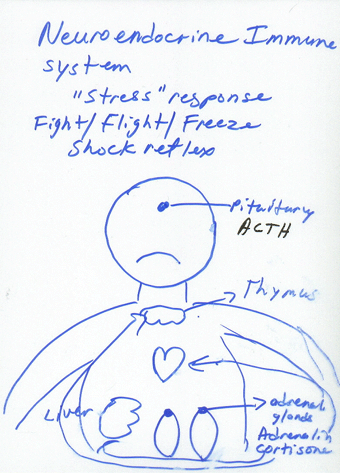
Cortisol also circulates up to the thymus and shuts down your immune system response, which is why people often get viral infections within a day or two after a serious shock. This probably also accounts for my finding that people with cancer, have a triple loss pattern, and the third shock occurs one to three years prior to the diagnosis. We could get into more detail about the effects of stress on the immune system, but I’m going to stay focused on the neuroendocrine reflex today. Basically, teaching this energy psychology technique to my clients, my colleagues, my students, is really not difficult. I just tell them that they can intentionally use their own neurological feedback mechanisms to turn off their phobic reactions. They’re happy with that.
(For a good summary of the effects of stress hormones see http://www.thedoctorwillseeyounow.com/articles/behavior/stress_3/)
Slide 10 Fight/ Flight/ Freeze Reflex
Sympathetic stress response = a mass discharge of the sympathetic nervous system.
Fight or flight reaction = an especially strong activation of the sympathetic nervous system also called the sympathetic alarm reaction
Let’s look more in depth at the neurochemistry of the fight/flight/freeze reflex. This is where you all have to really be awake, because this is the heavy neurochemistry part, which I know you’re all excited about, yes?
AUDIENCE: Yes.
JS: Okay, in physiological terms a mass discharge– and we all know what mass discharge means– a mass discharge of the sympathetic nervous system is called the sympathetic stress response. Now, the fight or flight reaction is an especially strong activation of the sympathetic nervous system, and it’s called the sympathetic alarm reaction. You think my colleague was alarmed when her husband told her he was leaving for the carpool lady? You bet she was alarmed.
The sympathetic alarm reaction is the scientific term for it the fight, flight, or freeze reflex in lay terms. You can understand that if the scientific term for stress is the sympathetic stress response, then the scientific term for the opposite reaction is called the relaxation response which I call the calming reflex in lay terms.
Slide 11 What triggers activation of the fight/flight/freeze reflex?
Physical stress or tissue damage that causes pain
Strong emotional reactions
Now we get into the alarm reaction. What triggers activation of the fight, flight, or freeze reflex? Physical stress or tissue damage that causes pain– we already heard about that– and strong emotional reactions.
Slide 12 How do these triggers activate the fight/flight/freeze reflex?
Pain stimuli transmitted up through the spinal cord & brainstem to hypothalamus.
Strong emotional reactions from external sensory information or recall of stored memories cause increased activity of the limbic system, particularly the amygdala and hippocampus which trigger the hypothalamus.
Strong emotional reactions can trigger the hypothalamus as strongly as physical pain stimuli!
So how do these triggers activate the fight, flight, or freeze reflex? Well, pain stimuli transmit up through the spinal cord and brainstem to the hypothalamus. Strong emotional reactions either come from external sensory information or recall of stored memories.
They cause increased activity of the limbic system, particularly the amygdala and the hippocampus, which trigger the hypothalamus. So again, we’re all going to see the hypothalamus– it all comes down to the hypothalamus. And strong emotional reactions can trigger the hypothalamus as strongly as physical pain stimuli. Isn’t that just a stunner? Isn’t this stuff great?
Slide 13 Reprinted by permission of Pearson Education, Inc. from Campbell, Neil A., Reece, Jane B., Mitchell, Lawrence, G. Biology, Addison Wesley Longman, Inc., Menlo Park, CA, 5th edition, 1999 p. 909.
It turns out that the amygdala has direct innervation to the thalamus, and that the speed at which the nerve transmission is generated down this way is faster than the speed that it is translated up to the cortical system. So you can actually have a reaction before you know you’re having a reaction. Do you understand that? That’s hardwiring, folks. That’s hardware.
So the danger signal comes through the system, triggers the thalamus, which triggers the hypothalamus, which releases corticotropic releasing factor, which releases ACTH from the pituitary, which, as you know, comes down to the adrenal cortex and causes the release of cortisol. Now, I didn’t want to get too technical for my lay people, but I want you to know that epinephrine and norepinephrine are not released through ACTH stimulation of the adrenal glands. Epinephrine and norepinephrine are released from the adrenal glands through stimulation by the sympathetic nervous system using norepinephrine neurons. The sympathetic stimulation of the adrenal glands is regulated through the hypothalamus and is simultaneous with ACTH release. Now, let’s think about this for a minute: you all know that epinephrine makes your heart beat faster and pumps you up so you can do extraordinary things with your muscle strength.
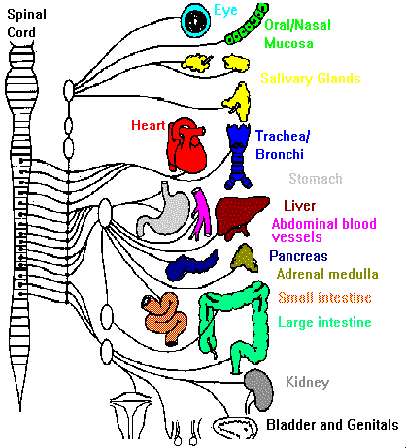
Slide 14 (http://faculty.washington.edu/chudler/auto.html)
This is the sympathetic nervous system. The sympathetic nervous system and parasympathetic nervous system are parts of the autonomic nervous system, which means really means automatic so I don’t know why they call it autonomic. Anyway, these systems unconsciously perform the housekeeping functions of the body. You can see that the sympathetic nervous system comes right down the spine. It innervates the adrenal glands. It affects the digestion. We’ve talked about the intestines, the bladder of course; when you really get frightened, you know what happens there– never mind. And of course the bronchi, right, the breathing goes right up in the chest, the heart and the eye– the pupil dilates.
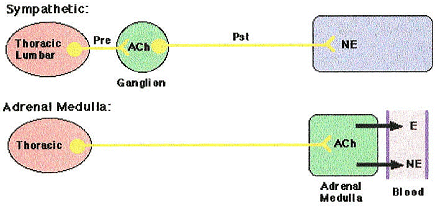
Slide 15 (This figure is from website http://members.aol.com/Bio50/ LecNotes/lecnot26.html).
This is the cross-section of your spine showing nerve transmission in the sympathetic nervous system. All of the transmission in the sympathetic nervous system is done through a two-nerve system. In other words, the pre-ganglionic nuclei– wake up everybody– the pre-ganglionic nuclei are acetylcholine-mediated neurons, and when they trigger the post-ganglionic sympathetic nerve, that nerve releases norepinephrine.
The exception is the sympathetic nerves that go to the adrenal glands. They go directly from the spine, without passing Go, without collecting $200, they go directly from the brain to the adrenal glands without an intermediate step. They are the only fibers in the sympathetic nervous system that go direct. What does that tell you? Transmission speed is critical. Save your skin. Now, the pre-ganglionic sympathetic nerves pass without synapsing to end directly in the adrenal medulla. There epinephrine and norepinephrine are released and are active in the circulation from one to several minutes. This release of epinephrine and norepinephrine can double your entire body metabolic rate; double, one hundred percent increase in your basal metabolism.
Now, you know that a nerve signal lasts for only a few seconds. So, what happens in the stress alarm reaction is that you have a norepinephrine release from the sympathetic nervous system that lasts for only seconds. It’s targeted to a particular tissue, so the effect is very localized. But when the adrenals release a massive dose of epinephrine and norepinephrine into the circulation, the effects go to every cell in your body and last for one to several minutes, not seconds, but minutes. So this is a serious reflex here.
Slide 16 Mass discharge of the sympathetic nervous system increases the ability of the body to perform vigorous muscle activity:
- Increased arterial pressure
- Increased blood flow to active muscles & decreased blood flow to organs such as the gastrointestinal tract and kidneys that are not needed for rapid motor activity
- Increased rates of cellular metabolism
- Increased blood glucose
- Increased muscle strength
- Increased mental activity
- Increased rate of blood coagulation
Mass discharge of the sympathetic nervous system increases the ability of the body to perform vigorous muscle activity– we’ve been over that several times. It increases the arterial pressure so you don’t bleed to death, you don’t go into cardiac shock. It increases blood flow to active muscles and decreases blood flow to organs such as the gastrointestinal tract and the kidneys that are not needed for rapid motor activity. It increases the rates of cellular metabolism, increased blood glucose, increased muscle strength, increased mental activity for emergencies: “What do we do now?” An increased rate of blood coagulation needs no explanation.
Slide 17 Functions of glucocorticoids
- raise blood glucose level by affecting cell metabolism
- raise blood fatty acid level
- block inflammation
- suppress the immune system, particularly T cells
- lower fever
- increase production of red blood cells
When the glucocorticoids get released– that’s cortisol and cortisone, they raise the blood glucose level by affecting cell metabolism. They raise blood fatty acid level because the muscles can use fatty acids as fuel, not just glucose. They block inflammation. Let’s say you’re gored by a woolly mammoth. Maybe you don’t want inflammation there. They suppress the immune system, particularly T-cells. Glucocorticoids lower fever and increase production of red blood cells. Well, that’s a good idea. If you don’t want to bleed to death, you may as well increase your production of red blood cells
Slide 18 How does the body downregulate the stress response?
- Cortisol feeds back to the hypothalamus and pituitary to shut down ACTH release and activation of the sympathetic stress response
- Endorphins inhibit the pain triggers and directly down regulate the cardiac reaction
Let’s look at how the body down-regulates the stress response by using the relaxation response to achieve homeostasis. Cortisol feeds back to the hypothalamus and pituitary to inhibit the ACTH release and down-regulate the sympathetic nervous system. Hey, cool. Opioid peptides, you’ve probably heard of them, also known as natural morphine, induce analgesia. They inhibit pain. Because pain is a trigger for the stress response, inhibiting pain turns off the trigger. Opioid peptides also induce a sense of well-being and enhance immune function counteracting the suppression of the immune system caused by the stress response. Opioid peptides mediate a decrease in heart rate, which is a good thing, because there are several examples of how people had heart attacks and died from emotional stress. It’s not just a folk tale, it actually is documented. So you want to be careful if you have a heart condition not to overstress yourself. (For an excellent description and review of how beta-endorphin inhibits ACTH release in the hypothalamo-pituitary-adrenal axis, see Jessop, D.S., Journal of Endocrinology (1999) 160, 169-180 online version available at http://journals.endocrinology.org/joe/160/0169/1600169.pdf.. Also see Slide 19 below from (http://www.med.monash.edu.au /biomed/courses/ BMS2031/Revision/HypothalamPituitary.pdf.)
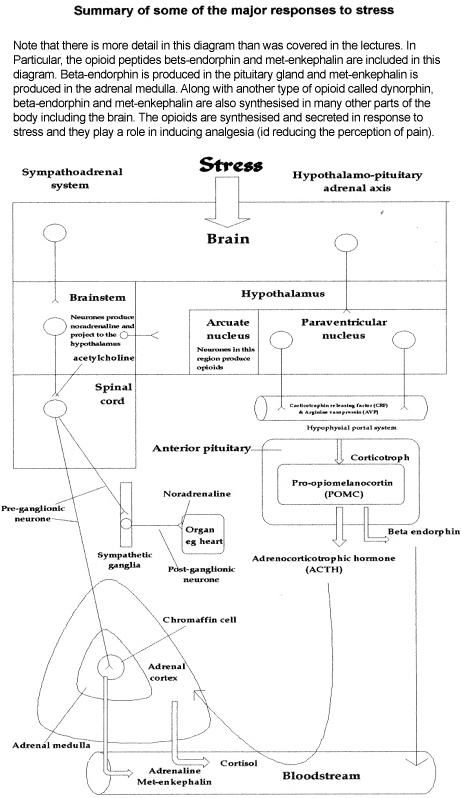
Slide 20 How does manipulation of certain areas on the surface of the body eliminate phobic reactions?
Neurochemical studies of activation of acupuncture meridian points demonstrate the release of cortisol and opioid peptides.
How does manipulation of certain areas on the surface of the body eliminate phobic reaction? Now we’re down to this, right? Neurochemical studies of activation of acupuncture meridian points demonstrate the release of cortisol and opiod peptides. There it is in a nutshell.
[Audience: ” Ooh”, Applause]
JS: Enkephalins mediate acupuncture analgesia, meaning pain relief, in the brain and spinal cord, and now you know what the pain triggers do. Dynorphins and endorphins mediate acupuncture analgesia in the brain. So it seems reasonable to conclude that stimulation of certain acupuncture meridian points on the surface of the body activates the relaxation response, which I am calling the calming reflex, through release of cortisol and opioid peptides. This inhibits the sympathetic alarm response which is also know as the fight/flight/freeze reflex.
How does manipulation of certain areas on the surface of the body eliminate allergic reactions? Well, it turns out that mast cells, which are the white cells that mediate the allergic response line the surface of your body. The reason that they line every surface of your body is because mast cells are made to protect you against parasites, and parasites enter through the skin, through the gut, through the linings of your lungs, through the linings of your body.
Mast cells really are there to organize a massive immune effort to chew up a parasite. Normally white blood cells can engulf a bacteria because it’s a little teeny thing. A white blood cell is big enough to engulf it and digest it. But a parasite is a big giant animal with lots of cells and you can’t engulf it with one little white cell, so you have to have a whole bunch of white cells coming into chew up this thing.
So you have be able to signal a whole bunch of cells to come in and jump on this parasite. The way that you do that is you have a mast cell that’s waiting to detect a parasite. When it does, it has granules inside of it that get released– that’s called mast cell degranulation– that are the signaling molecules to bring in all the cells to attack the parasite. And you thought you were having an allergic reaction; oh no, this is for parasites. The allergic reaction is a mistake, because tree pollen is just trees having sex. This is not a parasite. And trees having sex is a good thing. We want trees, yeah?
Well, it turns out that mast cell degranulation is stimulated directly by ACTH. Remember ACTH? And it’s inhibited by some of the opioid peptides, directly. Doesn’t that just give you goosebumps? My god.
(laughter)
JS: And look at this: the nervous system regulation supercedes immune regulation. Pretreatment of experimental animals with opioid peptides followed by allergen challenge prevented anaphylactic shock.
Audience: Ooh. Wow.
Slide 22 Nervous system regulation of mast cell degranulation.
JS: Okay, picture. Here’s the picture of it. This is a neuron. This is a mast cell. Now, normally in an allergic reaction the allergen, the antigenic component, is bound to the antibodies that recognize it. That’s what they test you for when they do the skin test. They test to see if you have IgE antibodies against that allergen. And if you do, if you’ve made antibodies against this allergen, the tail of them will sit down on the surface of a mast cell on an Fc receptor. And if you have an allergen sit down on a couple of Fc receptors that are close enough together, it will cause cross-linking.
See how far apart these are? If you get them close enough together and it brings them together it causes cross-linking. And when the receptors come together in cross-linkage, they cause degranulation of the mast cell, which of course has histamine in it and inflammatory cytokines, prostaglandins, chemotactic factors, and so on and so forth. So, basically, these soluble factors are released through this mechanism.
However, because mast cells are the only white cells in your body that don’t circulate– they actually sit down and localize someplace– they are directly innervated. And it turns out that these neurons contain ACTH as their neurotransmitters, and they also contain opioid peptides, although I don’t know if it’s the exact same neuron that has them. So you can see right here we have receptors for the neurotransmitters on the mast cell. If you challenge a mast cell here with allergen but you transmit an opioid peptide signal here, it will prevent degranulation.
AUDIENCE: Ooh.
JS: And that explains to me why you can turn off an allergic response like that: [snaps fingers] because there’s direct innervation. What do you think, folks?
[whoops and applause]
JS: So listen, there’s a story I want to tell you. I’ve had several people develop spontaneous bleeding around me. My daughter fell head into the edge of a bench. Somebody tripped her, it wasn’t her fault–
[laughter].
She cut her head so badly she needed seven stitches to the muscle inside and five to the skin outside. We are talking a serious cut, and she gushed blood. I applied pressure to her head immediately– I grabbed a napkin– this is a restaurant, no less– screamed for the manager to bring ice which we applied. Then I tapped her. I had somebody else hold the pressure while I tapped her, all fourteen meridians, and she stopped bleeding like that. [snaps fingers] And then I tapped myself.
[laughter]
JS: And then we calmly got in the car and drove to the emergency room, whereupon the triage nurse looked at her; she had an open gash with no blood coming out. So the nurse just put a piece of gauze over it, put a piece of tape on, and said, “It’s going to be three hours until we can see her, and I don’t know how soon we can stitch her after that because we have a lot of people here. You’ll jut have to wait. In other words, no hurry, at which point I said, “We’re going someplace else because I don’t like the service here.” We called up another hospital just ten minutes away, asked them if they were busy in their emergency room. They weren’t. We went; she was stitched in half an hour.
Same thing happened when our nanny’s friend brought her two year old over, she was sitting in her little chair, she rocked backwards, knocked her head into the back of a shelf, and cut the back of her head open. And I have to tell you, these head wounds, they gush. So of course we did the applied pressure, ice, and tap her like crazy, all fourteen meridians treatment, at which point she stopped bleeding like that [snaps fingers]. So we were able to call up the emergency room at the local hospital, tell them we were coming, get in the car, and drive over there. She needed two stitches back of her head, done. And my hairdresser cut her finger with the scissors while she was cutting my hair.
[laughter]
JS: Now, you have to know that that’s got to be something that in a twenty year career of hairdressing you figure they do occasionally, so I didn’t really think anything of it. She said, “Excuse me, I have to go get a Band-Aid.” I mean, she’s a grownup woman with two kids who are teenagers, my God, she knows how to use a Band-Aid. So I’m sitting there just getting my hair done. I’m off duty, She puts a Band-Aid on, she comes back, she says, “It’s still bleeding,” and then she says, “and it’s pulsing.”
Then I knew that she had traumatized to this cut. What can you say? You never know. Little things can cause trauma. I said, “Oh, come here.” [laughter]
JS: And I put my hand on it. I just took a quick read on which meridian was out, I had her tap on the armpit point. In ten seconds it had stopped bleeding. I said, “Now, if you could finish cutting my hair please. Thank you.”
[laughter]
JS: But I didn’t understand why the bleeding would stop so fast. Why was it just like that? I mean, serious gashes, no blood. Figure that out. The famous Norma Feldman figured it out. She told me, “Well, Judith, it’s because their heart stops pumping so hard,” and I’m like, “Oh, right.” Well, guess what, now I know why. Its because the opioid receptors feed back directly to the heart to neutralize the pumping. So basically we’ve got a whole bunch of reproducible phenomena with what I think is a good explanation. Did you all stay away during my explanation?
AUDIENCE: Yes.
JS: And I don’t see anything mysterious about this at all, frankly. I think this is just biology. The original title of my seminar was “Energy Psychology Isn’t Weird, It’s Biology.” Now you know exactly what I mean, right? So when you teach this to your colleagues and your friends and whatever, don’t get weird, get biology.
[laughter]
JS: Okay, that’s the end of the seminar to this point. [applause, whooping] JS: And now we have to do the quiz, the post-test evaluation.
The Biochemistry of Energy
Psychology:
An Immunologist’s Perspective on Physiological Mechanisms Underlying Energy Psychology Treatments Presenter:
Judith A. Swack, Ph.D.
Post-Test Evaluation:
The name of one physiological mechanism likely to help make plausible the idea that Energy Psychology interventions may produce reliable treatment effects is: ______________
The study by Judith Swack, Ph.D. appears to demonstrate that ________________
One implication that can be responsibly derived about energy psychology treatment efficacy from the field of biochemistry is:
- energy psychology interventions can’t possibly work
- energy psychology interventions indisputably work
- there is some research and theoretical support from the field of physiology that energy psychology interventions may be capable of producing reliable psychotherapeutic treatment effects;
- None of the above
Answer Key:
Sympathetic alarm response or fight or flight reflex
Allergic responses are mediated neurologically
(3)
Presenter: Judith Swack, Ph.D.
Plenary Speech Presented at the 2001 Energy
Psychology Conference
(Original Title: Energy Psychology Isn’t Weird; It’s Biology)


CONTACT US
Healing From The Body Level Up, Inc.
56 Pickering St.
Needham, MA 02492
(800) 310-6549 / (781) 444-6940
SUBSCRIBE
Sign up For A Free Webinar Replay for The Impossible is not Impossible.
Newsletter Signup Footer
Thank you for joining our monthly newsletter!
Please try again later.

